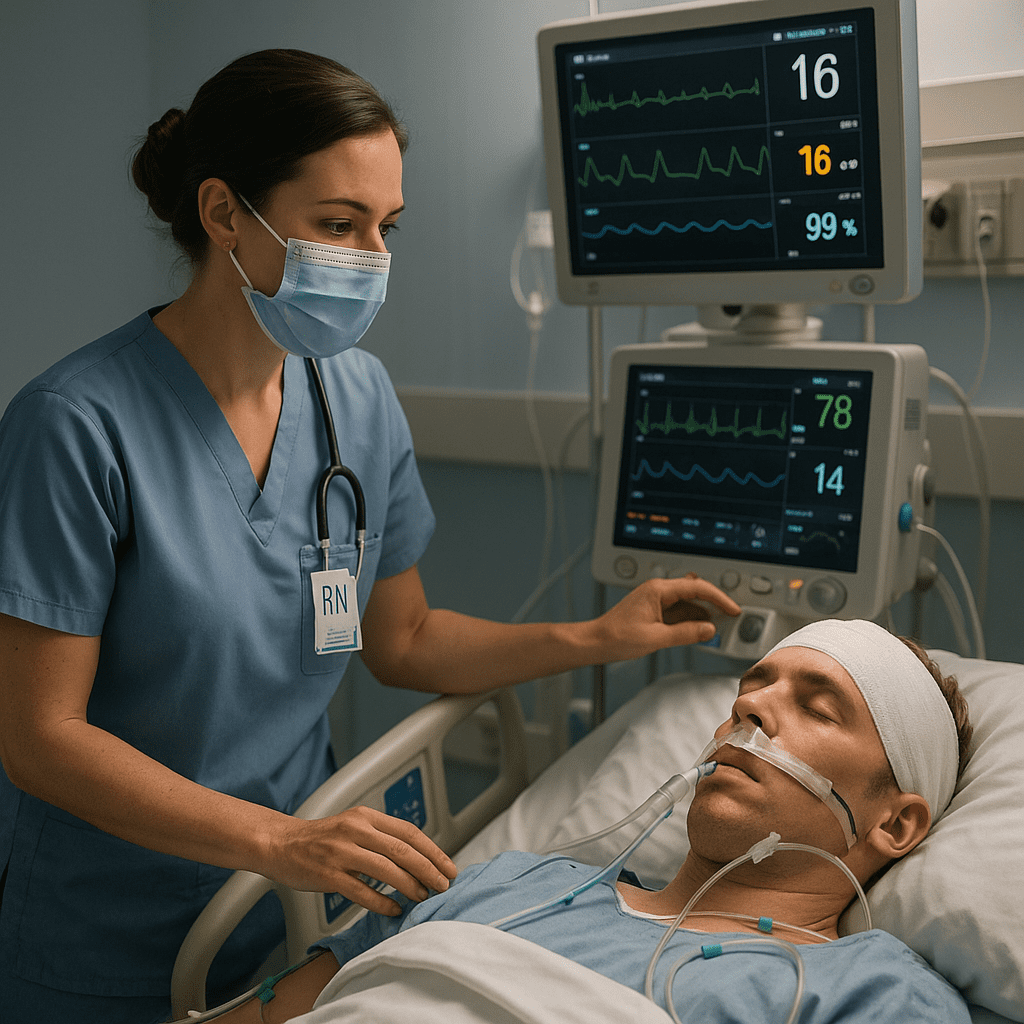Understanding the Basics
Head injuries are among the most critical emergencies nurses encounter. For every RN nurse and registered nurse preparing for the NCLEX, understanding Intracranial Pressure (ICP) monitoring and nursing priorities is essential. Managing patients with head trauma requires quick recognition, accurate assessment, and immediate intervention to prevent secondary brain injury.
What Is Intracranial Pressure (ICP)?
Intracranial Pressure (ICP) refers to the pressure within the skull caused by brain tissue, blood, and cerebrospinal fluid (CSF). The normal ICP range is 5–15 mmHg. When ICP rises above this threshold, it can lead to brain herniation and irreversible damage.
As a nurse, your main role is to monitor for early signs of increased ICP and act quickly.
🚨 Early Signs of Increased ICP
A registered nurse should recognize these warning signs immediately:
- Headache (often severe and constant)
- Nausea or vomiting (projectile type)
- Decreased level of consciousness (LOC)
- Pupillary changes (unequal, sluggish, or fixed)
- Cushing’s Triad:
- ↑ Blood Pressure (widened pulse pressure)
- ↓ Heart Rate (bradycardia)
- Irregular Respirations
🩺 NCLEX Tip: Cushing’s triad = late sign of increased ICP — requires immediate action!
Nursing Priorities in Head Injury Care
When caring for a patient with a head injury, nursing interventions must focus on maintaining cerebral perfusion and preventing further complications.
1. Maintain Airway and Oxygenation
- Keep SpO₂ above 95%.
- Elevate head of bed 30° (unless contraindicated).
- Avoid neck flexion or rotation — it impedes venous return.
2. Monitor Neurological Status
- Use the Glasgow Coma Scale (GCS) every 1–2 hours.
- Observe for any change in pupils or motor response.
3. Manage ICP
- Keep ICP < 20 mmHg.
- Administer mannitol or hypertonic saline as prescribed.
- Avoid overstimulation (loud noises, frequent repositioning).
4. Prevent Secondary Injury
- Control fever — hyperthermia increases ICP.
- Avoid hypotension (maintain MAP > 70 mmHg).
- Monitor for seizures and start anticonvulsants if needed.
🧾 ICP Monitoring Devices
Registered nurses working in critical care should be familiar with common ICP devices:
- Intraventricular catheter – most accurate; allows CSF drainage.
- Subarachnoid bolt – less invasive, measures pressure only.
- Epidural sensor – least invasive, lower accuracy.
📘 Nursing bundle tip: Always ensure the transducer is leveled at the tragus of the ear (foramen of Monro) and zeroed properly to ensure accurate readings.
💊 Common Medications in ICP Management
| Drug | Action | Nursing Implications |
|---|---|---|
| Mannitol | Osmotic diuretic to reduce brain swelling | Monitor urine output and serum osmolality |
| Hypertonic Saline (3%) | Draws fluid out of the brain tissue | Watch for hypernatremia |
| Phenytoin | Prevents seizures | Monitor drug levels |
| Sedatives (propofol, midazolam) | Reduces brain metabolism | Monitor BP, respiratory rate |
⚕️ NCLEX Nursing Bundle Quick Review
When studying this topic in your nursing bundle or NCLEX review:
✅ Know the normal ICP range (5–15 mmHg)
✅ Identify Cushing’s triad as a late sign
✅ Review ICP nursing interventions (airway, positioning, fluids, medications)
✅ Understand how ICP monitors are leveled and maintained
🧩 Final Thoughts
Head injury nursing demands vigilance and rapid decision-making. Whether you’re a student nurse or registered nurse, mastering ICP monitoring and prioritization can truly save lives. Always remember: the brain has no room for error — prevention and early action make the biggest difference.
❓ FAQs About Head Injury Nursing and ICP Monitoring
The normal ICP range is 5 to 15 mmHg. If pressure rises above 20 mmHg, it’s considered elevated and can lead to brain tissue damage. Every RN nurse and registered nurse should monitor ICP closely in patients with head injuries to prevent complications.
Early signs include headache, vomiting, confusion, decreased level of consciousness, and pupil changes. Nurses should also watch for Cushing’s triad—bradycardia, hypertension, and irregular breathing—which are late signs of increased ICP.
Nursing interventions to lower ICP include:
Keeping the head of bed elevated to 30°
Avoiding neck flexion or tight tracheostomy ties
Administering prescribed osmotic diuretics (mannitol) or hypertonic saline
Maintaining adequate oxygenation and avoiding hypoxia
Reducing external stimulation (dim lights, limit visitors)
The registered nurse must ensure the ICP monitor is properly leveled, zeroed, and secured. The nurse monitors readings, documents changes, and reports any sudden spikes to the healthcare provider. Regular checks prevent inaccurate readings and patient harm.
Common drugs include mannitol, hypertonic saline, phenytoin (for seizures), and sedatives like propofol. These medications help reduce brain swelling and control intracranial pressure. During NCLEX prep, nurses should remember to monitor vital signs, fluid balance, and neurological status when giving these medications.

